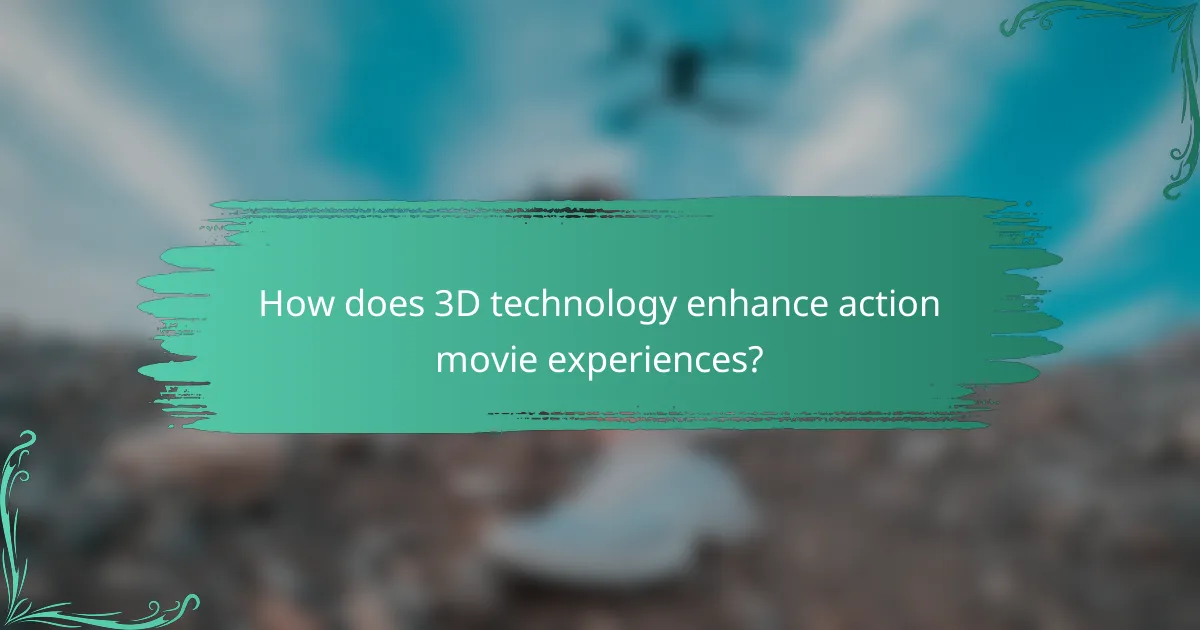3D technology has revolutionized the way action movies are experienced, offering viewers an unparalleled sense of depth and immersion that traditional 2D films simply cannot provide. By engaging multiple senses, this technology transforms thrilling action sequences into realistic and captivating experiences, making them more enjoyable for enthusiasts of the genre.

How does 3D technology enhance action movie experiences?
3D technology significantly enhances action movie experiences by providing viewers with a sense of depth and immersion that traditional 2D films cannot match. This technology engages multiple senses, making the action sequences more thrilling and realistic.
Increased depth perception
Increased depth perception in 3D films allows viewers to better gauge distances and spatial relationships between characters and objects. This heightened awareness can make chase scenes or battles feel more intense, as audiences can visually track movements and actions in a three-dimensional space.
For instance, when a character leaps from a building, the perception of depth helps viewers feel the height and danger involved. This effect can be particularly impactful in scenes with fast-paced action, where understanding the spatial dynamics enhances overall engagement.
Enhanced realism in visuals
Enhanced realism in visuals is a hallmark of 3D technology, as it creates lifelike images that draw viewers into the film’s world. By utilizing stereoscopic techniques, filmmakers can produce vibrant colors and intricate details that make scenes appear more tangible.
For example, explosions and special effects in 3D can seem to leap off the screen, making the viewer feel as though they are part of the action. This realism not only captivates the audience but also heightens emotional responses during critical moments.
Immersive sound design
Immersive sound design complements 3D visuals by creating a multi-dimensional audio experience that enhances the storytelling. Sounds can be strategically placed to match the visual elements, making explosions, footsteps, and dialogue feel more immediate and engaging.
For instance, a sound that originates from the left side of the screen can lead viewers to turn their heads, simulating a real-world experience. This auditory immersion is crucial in action films, where sound effects play a vital role in building tension and excitement.
Interactive viewing experiences
Interactive viewing experiences in 3D films can include elements like audience participation or augmented reality features that allow viewers to engage with the content actively. Some theaters offer interactive seats that vibrate or move in sync with the action, further enhancing immersion.
Additionally, advancements in technology may allow for viewer choices that affect the storyline, creating a unique experience for each audience member. This interactivity can deepen emotional investment in the film, making action sequences even more thrilling and memorable.

What are the best 3D movies for action enthusiasts?
Action enthusiasts will find that some 3D movies deliver an immersive experience that enhances the thrill of the genre. The following films stand out for their exceptional use of 3D technology, providing depth and realism that elevate the action sequences.
Avatar (2009)
Directed by James Cameron, “Avatar” is renowned for its groundbreaking use of 3D technology, which immerses viewers in the lush world of Pandora. The film’s visual effects and depth perception create a stunning backdrop for its action-packed narrative, making it a must-see for fans of the genre.
The film’s innovative use of motion capture technology allows for realistic character movements, enhancing the overall experience. The combination of vibrant visuals and engaging action sequences sets a high standard for 3D films.
Mad Max: Fury Road (2015)
“Mad Max: Fury Road” is a high-octane action film that utilizes 3D to amplify its intense chase scenes and explosive visuals. The film’s practical effects, combined with 3D technology, create a visceral experience that keeps viewers on the edge of their seats.
The depth provided by the 3D enhances the sense of speed and danger, making the action sequences feel more immediate and impactful. This film is a prime example of how 3D can enhance the storytelling in action cinema.
Gravity (2013)
Alfonso Cuarón’s “Gravity” is a visually stunning film that uses 3D to create a sense of weightlessness and isolation in space. The film’s breathtaking visuals and immersive sound design work together to pull viewers into the heart of its suspenseful narrative.
The 3D effects are particularly effective during the intense action sequences, where the depth perception adds to the tension and urgency. This film showcases how 3D can be used not just for spectacle, but to enhance emotional engagement in action films.
Transformers: Dark of the Moon (2011)
“Transformers: Dark of the Moon” features spectacular 3D effects that bring the epic battles between Autobots and Decepticons to life. The film’s use of 3D enhances the scale of the action, making the giant robots feel more imposing and the battles more chaotic.
The combination of fast-paced action and detailed 3D visuals creates an engaging experience for action fans. While the plot may be secondary, the visual spectacle is a testament to the potential of 3D technology in action filmmaking.

Which 3D technologies are used in filmmaking?
Filmmaking utilizes several key 3D technologies to enhance depth, realism, and viewer engagement. The primary technologies include digital 3D cameras, motion capture, and virtual reality integration, each contributing uniquely to the cinematic experience.
Digital 3D cameras
Digital 3D cameras capture images in a way that mimics human binocular vision, creating a sense of depth. These cameras often use two lenses to record two slightly different perspectives, which are then combined in post-production to produce a three-dimensional effect.
When selecting a digital 3D camera, filmmakers should consider factors such as resolution, frame rate, and lens quality. Popular models include the RED Epic and the Sony F65, which are known for their high-quality output and versatility in various shooting conditions.
Motion capture technology
Motion capture technology records the movements of actors and translates them into digital models, allowing for realistic animations in 3D films. This technology often employs sensors placed on the actor’s body to track movements, which are then mapped onto a digital character.
Filmmakers should be aware of the importance of a controlled environment for motion capture to minimize errors. Popular films like “Avatar” and “The Lord of the Rings” series have effectively used motion capture to create lifelike characters and enhance storytelling.
Virtual reality integration
Virtual reality (VR) integration in filmmaking allows audiences to immerse themselves in a 3D environment, enhancing the overall viewing experience. VR can be used for interactive storytelling, where viewers can influence the narrative through their actions within the virtual space.
When incorporating VR, filmmakers should focus on user experience and interactivity. Tools like Oculus Rift and HTC Vive provide platforms for VR content creation, enabling filmmakers to explore new storytelling techniques that engage viewers on a deeper level.

How do 3D formats differ in action films?
3D formats in action films vary primarily in their technology and viewer experience, impacting depth perception and realism. Each format uses different methods to create the illusion of three-dimensionality, which can enhance or detract from the overall enjoyment of fast-paced scenes.
RealD 3D
RealD 3D employs circular polarization technology, allowing viewers to wear lightweight glasses that filter light for each eye. This format is widely used in theaters and provides a bright, clear image, making it suitable for vibrant action sequences.
One key consideration with RealD 3D is the viewing angle; the effect can diminish if viewers are not seated directly in front of the screen. This format is often favored for its accessibility and compatibility with standard cinema setups.
IMAX 3D
IMAX 3D enhances the action film experience by using larger screens and advanced projection systems that deliver higher resolution images. This format often combines dual projection systems to create a more immersive depth effect, making it ideal for visually stunning action scenes.
IMAX theaters typically have a steeper seating arrangement, which helps maintain the 3D effect from various angles. However, tickets can be more expensive than standard formats, so consider this when planning your movie outing.
Dolby Vision 3D
Dolby Vision 3D integrates high dynamic range (HDR) technology with 3D visuals, resulting in enhanced color accuracy and contrast. This format is designed to provide a more lifelike experience, particularly in dark scenes common in action films.
While Dolby Vision 3D is available in select theaters, it may not be as widely accessible as RealD or IMAX. When watching films in this format, expect a premium experience that showcases the full potential of modern filmmaking techniques.

What are the prerequisites for enjoying 3D movies?
To fully enjoy 3D movies, you need the right equipment, a suitable viewing distance, and an understanding of how 3D effects work. These factors significantly enhance the immersive experience that 3D films offer.
Compatible viewing equipment
Having compatible viewing equipment is essential for enjoying 3D movies. This typically includes a 3D-capable television or projector and the appropriate 3D glasses. Look for devices that support popular 3D formats like Blu-ray 3D or streaming services that offer 3D content.
When choosing equipment, ensure it meets the latest standards, such as HDMI 2.0 or higher, to handle the increased data required for 3D playback. Brands like Samsung, LG, and Sony often provide reliable options for 3D viewing.
Proper seating distance
The seating distance from the screen can greatly affect your 3D viewing experience. Ideally, you should sit at a distance that is 1.5 to 2.5 times the diagonal size of your screen. For example, if you have a 55-inch TV, sitting between approximately 6.5 to 11 feet away is recommended.
Maintaining the right distance helps prevent discomfort and allows for optimal depth perception. Avoid sitting too close, as this can lead to a distorted view of the 3D effects.
Understanding 3D effects
Understanding how 3D effects work is crucial for appreciating the depth and realism they provide. 3D movies create the illusion of depth by presenting slightly different images to each eye, mimicking natural vision. Familiarize yourself with terms like stereoscopic vision and depth perception to enhance your viewing experience.
Be aware that not all 3D movies are created equal; some may use more effective techniques than others. Pay attention to reviews or ratings that highlight the quality of the 3D effects before choosing a film to watch.
